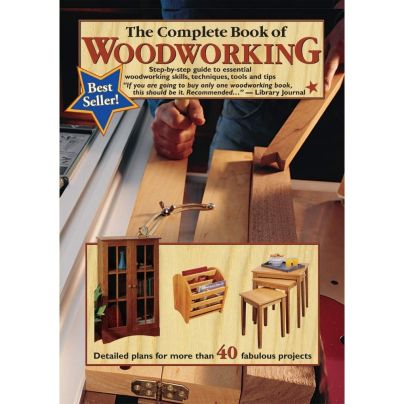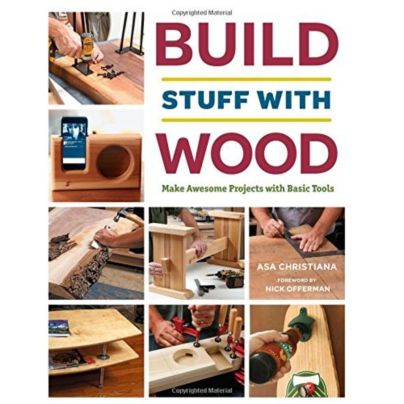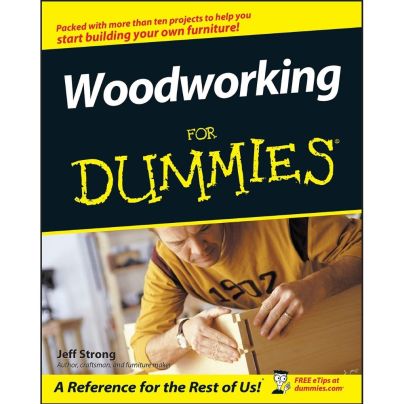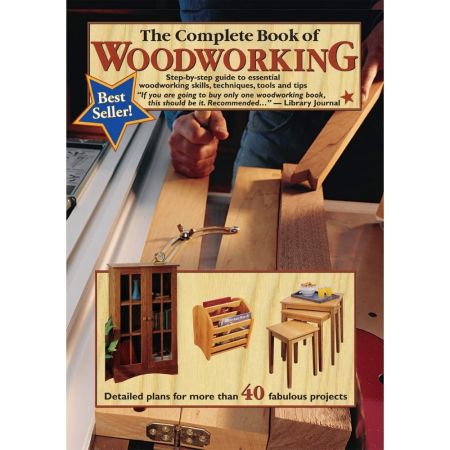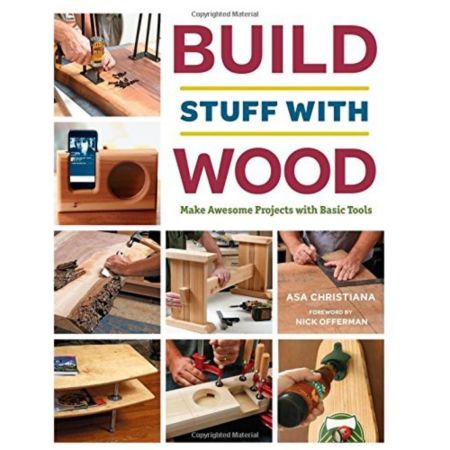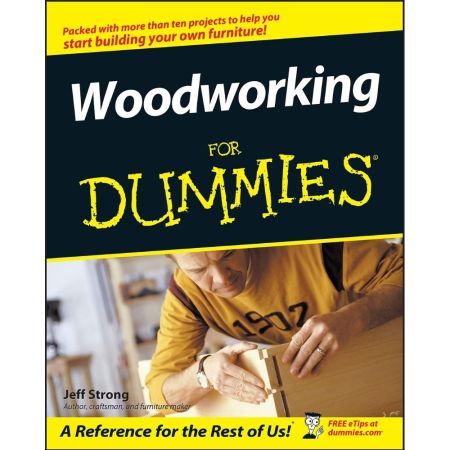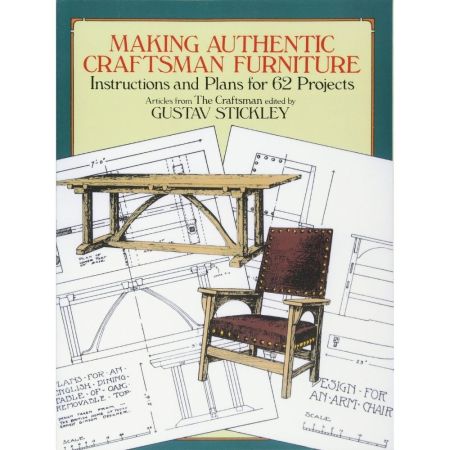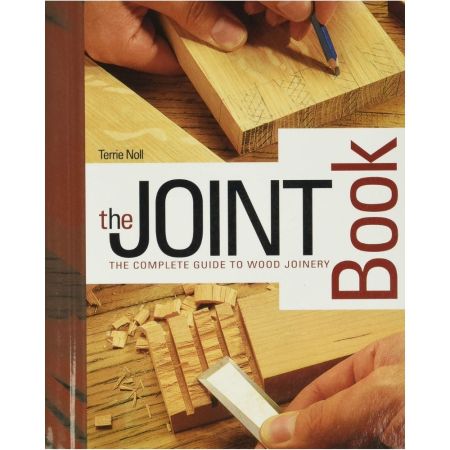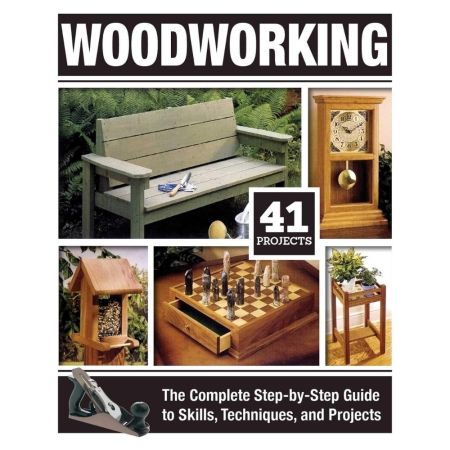We may earn revenue from the products available on this page and participate in affiliate programs. Learn More ›

If you are interested in acquiring a new hands-on skill, you’d be hard-pressed to find something better than learning the craft of woodworking. Woodworking is one of the most fundamental skills humanity has ever developed. Perhaps you have a space in your home that is crying out for a woodworking shop and you want to start learning the basics, or maybe you want to challenge your woodworking skills with new projects.
No matter why you want to learn, it’s helpful to have solid reference material from reliable sources that cover the fundamentals as well as giving you step-by-step guidance to creating projects. Many woodworking books enable you to advance beyond the basics, propelling you toward greater levels of woodworking mastery in the future. The following titles are some of the best woodworking books for honing your craft.
- BEST OVERALL: The Complete Book of Woodworking
- BEST BANG FOR THE BUCK: Build Stuff with Wood
- BEST FOR BEGINNERS: Woodworking For Dummies
- BEST FOR MAKING FURNITURE: Making Authentic Craftsman Furniture
- BEST ON JOINERY: The Joint Book: The Complete Guide to Wood Joinery
- BEST WITH PLANS: Woodworking: The Complete Step-by-Step Guide

What to Consider When Buying the Best Woodworking Books
Woodworking is a wonderful craft to learn and a great way to improve your home. Here are some of the major factors to keep in mind when choosing the best book to sharpen your craft.
Author Expertise
Learning the techniques and skills from someone with a fair amount of experience in the field of woodworking, carpentry, or joinery is essential. A respected author of any how-to volume may have written multiple books on woodworking or carpentry, have a solid reputation as a professional, or have extensive teaching experience. Alternatively, an author might have held a prominent or well-regarded position in the professional field, such as an editor of a woodworking or carpentry magazine.
Skill Level
At some point, everyone starts as a beginner. For example, your first workshop may consist of a few tools and a small space in your basement where a laundry drying rack used to be. Even a meager knowledge of the craft and the most basic tools can still yield impressive beginner woodworking projects for your home.
The skill levels between absolute novice and master craftsman are numerous. You may have a fair bit of knowledge about furniture making but know little about framing a house. Even the most highly skilled craftsmen will still need to brush up on the basics and learn about new tools from time to time. There are always new tips, tricks, and technologies that can change how someone approaches the craft of woodworking.
Woodworking Subjects
Of the major subjects that woodworking books address, like tools, wood types, fasteners, and finishing, the first and foremost thought on any woodworker’s mind should be safety. All the books listed here, which were written for a beginner skill level, cover the topic of safety in detail.
The fundamentals of the craft are included in most woodworking books. For example, the best books include the kinds of tools needed, the differences among types of wood, or the basic terminology used by professionals. In the case of more advanced workers, the fundamentals are good to have on hand as a refresher, for inspiration, and to admire other people’s work.
For any skill level, a helpful woodworking resource also includes clear and concise descriptions and plans of the project you plan to approach. These are the foundations upon which you will build your knowledge–and your project.
Finally, if the book is an overview of woodworking, it may cover more advanced subjects like joinery, furniture making, and a few plans for projects you can try. Some of the more popular plans include a simple wooden box or footstool and can be as complicated as a full dining table or a dresser. The only way to become a master woodworker is to get your hands busy and start producing some sawdust.
Our Top Picks
To help you find the best woodworking books for honing your craft, this guide took into consideration the different skill levels that readers might have. These recommendations reflect expertise and strong author credentials, and the most popular types of projects you might undertake for your woodworking journey. Here are the top picks for a variety of woodworking ambitions.
Best Overall
The Complete Book of Woodworking
See ItFeaturing 40 project plans for woodworkers of all skill levels, more than 1,200 step-by-step illustrations, and 480 pages of helpful diagrams and instructions, this is one of the most comprehensive guides to woodworking. It can serve as a useful learning tool for beginners and experts alike.
Novice woodworkers are introduced to the basic principles of design, tool basics, how to set up shop, and the essential woodworking techniques that will propel your projects and knowledge. Each project comes with a detailed list of every cut, including parts, size, numbers, and materials.
There are dozens of tips and tricks from seasoned woodworkers, including equipment do’s and don’ts that can be essential for professional-looking products as well as shop safety.
Experts can refresh their knowledge and skills with professional insights from seasoned woodworkers on topics that include how to make jigs and joints and how to put on those finishing touches.
The main author, Tom Carpenter, has written numerous books on woodworking. His passion for and expertise in the craft show on every page.
Best Bang for the Buck
Build Stuff with Wood
See ItWhen thinking of a woodworking shop, images may come to mind of several large, intimidating machines in a cavernous shed filled with sawdust and piles of lumber. Build Stuff With Wood by Asa Christiana, the former chief editor of Fine Woodworking Magazine, dispels the idea that you need thousands of dollars of equipment to build cool wooden treasures.
This book is an excellent and inexpensive beginner’s guide to woodworking, designed for those who have few tools and aren’t sure where to start. The book features 14 projects, many of which can be completed with a few basic tools like a jigsaw and cordless drill.
Later projects increase in difficulty as you add tools to the workshop and your skills increase. The progression allows you to become more familiar with the usefulness and applications for each tool as you advance toward greater woodworking achievements.
Best for Beginners
Woodworking For Dummies
See ItWoodworking For Dummies includes the essentials you need to get started with the craft of woodworking. It includes the foundations of what tools to use, the finer points of glues and adhesives, the types of wood available, and how they are processed, and sanding and filling. This beginner tome goes even further, giving you a comprehensive overview of the woodworking world.
Whether you want to make a simple set of shelves for your books or have the ambition to create a solid oak dining table, this book lays it all out for you. The Dummies books have decades of experience condensing complex subjects into easily consumable texts to provide a solid explanation of the subject. Woodworking For Dummies is an excellent all-around introduction to the craft.
Best for Making Furniture
Making Authentic Craftsman Furniture
See ItGustav Stickley has been regarded as one of the most influential designers of American furniture for many years. Craftsman, his monthly magazine, was one of the most important publications in this field for almost two decades. This book has been a must-have for any furniture maker since it was first published more than 30 years ago.
Stickley’s influence was most significant at the beginning of the 20th century, but his popularity has been in a resurgence for several decades. His style has been called timeless because of both the construction’s sturdiness and the elegant simplicity of his designs.
This book contains plans for 62 of his finest pieces, allowing different skill levels of woodworkers to find a project best suited to their abilities. Beginners may enjoy the simple wood box or footrest plans. The more seasoned woodworker may prefer the more complex bookcase and bedsteads plans or perhaps even a more ambitious dresser or dining table.
Each project includes the original directions for the early 20th-century woodworkers, allowing woodworking purists to develop their craft. The project plans also include complete lumber specifications, schematic drawings showing front and side views, accurate measurements, and suggestions for types of wood to use.
Best on Joinery
The Joint Book: The Complete Guide to Wood Joinery
See ItWhile there are overlaps between a carpenter and a joiner, there are differences between the two. A carpenter works on a job site to construct almost anything related to wood. On the other hand, a joiner has more specialized skills when it comes to making construction components like window and door frames, stairs, and furniture.
Whether or not a piece of woodworking stays together or not depends on the quality of the joints. The Joint Book features detailed instructions on more than 70 joints like mortise and tenon joints, miters and bevels, dovetails, as well as descriptions of the fasteners, knockdown joints, and hardware involved in your journey toward woodworking excellence.
The author, Terrie Noll, has 20 years of experience as a furniture designer, maker, and purchasing agent for specialty woodworking shops. She has three books published on the subject of joinery. Her credibility makes The Joint Book a worthy purchase for learning both the fundamentals and finesses of joinery.
Best with Plans
Woodworking: The Complete Step-by-Step Guide
See ItWoodworking: The Complete Step-by-Step Guide from author Tom Carpenter is a 448-page book that includes more than 1,200 illustrations and easy-to-follow diagrams for skill-building and fashioning great woodworking projects. It also includes essential information like choosing the appropriate wood, measuring, marking, and cutting it to construct the final product.
The 41 detailed projects for both indoor and outdoor furnishings and accessories are both practical and impressive. Woodworking: The Complete Step-by-Step Guide contains the information and project plans needed for a beginning woodworker to develop an enriching hobby that will last a lifetime. It also can be a valuable reference companion for whenever an experienced woodworker needs it.
FAQs About Your New Woodworking Books
If you still have questions regarding woodworking, check out the answers to some of the most common questions below. Remember to stay safe while working, and always try to have fun while creating your masterpieces.
Q. What are the basic tools for woodworking?
Seven of the most essential woodworking tools are a tape measure, a combination square, a torpedo level, a hammer, a bevel gauge, a set of chisels, and a block plane.
Q. Can you make money woodworking at home?
A professional woodworker can make a median income of $32,000 a year. Home woodworkers can bring in extra cash depending on the skill level and the demand for the items made.
Q. What woodworking items ted to sell the best?
Some of the best-selling woodworking items include wooden toys, coffee-mug racks, picture frames, corner wall shelves, and wooden furniture.
Q. How do you price a woodworking project?
The price can vary depending on the size of the project, the time involved, marketing costs, and the skill level required to complete it. Some woodworkers mark up a project by adding a rate of 15 to 20 percent on top of the costs. Another way to price a woodworking project is to multiply the cost of the materials used by three.
